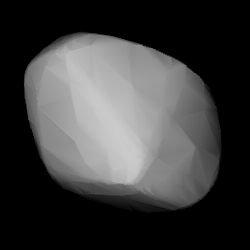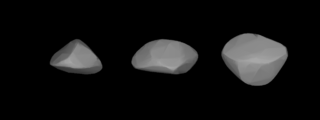Related Research Articles

Dejanira is a main belt asteroid that was discovered by Alphonse Borrelly on 1 December 1875, and named after the warlike princess Deianira in Greek mythology. The Dejanira family of asteroids is named after it.

191 Kolga is a large, dark main-belt asteroid that was discovered by German-American astronomer C. H. F. Peters on September 30, 1878, in Clinton, New York. It is named after Kólga, the daughter of Ægir in Norse mythology.

199 Byblis is a medium-sized main belt asteroid.

Philosophia is a large main-belt asteroid that was discovered by the French astronomer Paul-Pierre Henry on August 12, 1882, in Paris and named after the topic of philosophy. Based upon photometric observations, it has a synodic rotation period of 52.98 ± 0.01 with a brightness variation of 0.15 ± 0.02 in magnitude.

Germania is a very large main-belt asteroid. It is classified as a B-type asteroid and is probably composed of dark, primitive carbonaceous material.

Augusta is a main-belt asteroid, discovered on 31 March 1886 by astronomer Johann Palisa at Vienna Observatory, Austria. The stony S-type asteroid measures about 12 kilometers in diameter. It is the first-numbered member of the Augusta family, after which the small Asteroid family and subgroup of the main-belt has been named. Augusta was named after the German–Austrian writer Auguste von Littrow (1819–1890), widow of astronomer Carl Ludwig von Littrow, who was a former director of the Vienna Observatory.

Valda is a main belt asteroid that was discovered by Austrian astronomer Johann Palisa on 3 November 1886 in Vienna. The name was proposed by Bettina von Rothschild.

Bavaria is a carbonaceous background asteroid from the intermediate asteroid belt, approximately 54 kilometers. It was discovered by Johann Palisa on 16 November 1890 in Vienna.

Persephone is a main belt asteroid. It was discovered by German astronomer Max Wolf on 23 February 1895 in Heidelberg.
Virtus is an 86 km minor planet orbiting the Sun. It was discovered by Max Wolf on October 7, 1902. Its provisional name was 1902 JV.
Brixia is a relatively large minor planet, specifically an asteroid orbiting mostly in the asteroid belt that was discovered by American astronomer Raymond Smith Dugan on January 10, 1904. The name derives from Brixia, the ancient name of the Italian city of Brescia.

Rezia is a minor planet orbiting the Sun. It was discovered by Max Wolf on March 20, 1904. It is named for a character in the 1826 opera Oberon by Carl Maria von Weber. Among the 248 discoveries by Wolf, he also discovered 527 Euryanthe and 529 Preziosa on the same day.
Kythera is a large, main belt asteroid orbiting the Sun. It was discovered in 1905 by German astronomer M. F. Wolf at Heidelberg, and was named after the Greek island of Kythira that is associated with Aphrodite. The object is a member of the Cybele asteroid group.

631 Philippina is a minor planet orbiting the Sun that was discovered by German astronomer August Kopff on March 21, 1907.
633 Zelima is a minor planet orbiting the Sun in the asteroid belt with a magnitude of 10.7. The name may have been inspired by the asteroid's provisional designation 1907 ZM.
635 Vundtia is a minor planet orbiting the Sun - though this claim has been disputed.
639 Latona is a minor planet, specifically an asteroid orbiting in the asteroid belt. It was discovered by German astronomer Karl Lohnert on July 19, 1907, at Heidelberg.
11714 Mikebrown, provisional designation 1998 HQ51, is a stony background asteroid from the central region of the asteroid belt, approximately 4.5 kilometers (2.8 miles) in diameter. It was discovered on 28 April 1998, by astronomers of the Lowell Observatory Near-Earth Object Search (LONEOS) at the U.S. Anderson Mesa Station near Flagstaff, Arizona, and later named after American astronomer Michael Brown.
6144 Kondojiro (1994 EQ3) is an asteroid discovered on March 14, 1994 by Kin Endate and Kazuro Watanabe at the Kitami Observatory in eastern Hokkaidō, Japan. It is named after Jiro Kondo, a Japanese Egyptologist and professor of archaeology at Waseda University.
2021 LL37 is a large trans-Neptunian object in the scattered disc, around 600 kilometres (370 miles) in diameter. It was discovered on 12 June 2021, by American astronomers Scott Sheppard and Chad Trujillo using Cerro Tololo Inter-American Observatory's Dark Energy Camera in Chile, and announced on 31 May 2022. It was 73.9 astronomical units from the Sun when it was discovered, making it one of the most distant known Solar System objects from the Sun as of May 2022. It has been identified in precovery images from as far back as 28 April 2014.
References
- ↑ Noah Webster (1884) A Practical Dictionary of the English Language
- 1 2 "JPL Small-Body Database Browser: 625 Xenia(1907 XM)" (18 January 2013 last obs). Retrieved 5 May 2016.
- 1 2 JPL Small-Body Database Browser